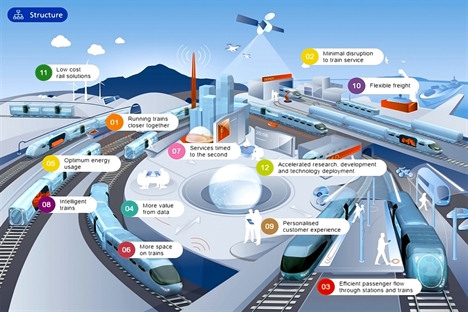14.03.17
The age of the digital train
Source: RTM Feb/Mar 17
Paul Plummer, chief executive of the Rail Delivery Group (RDG), says that a blueprint for how the rail industry embraces technology and innovation is essential if we are to tackle the capacity crunch.
Modernising Britain’s railway is essential if we are to tackle the capacity crunch on our network and provide passengers with the seamless experience they increasingly get from other goods and services they buy.
Launching a blueprint of Britain’s railway in the digital age, the RDG invited rail industry leaders to its conference in Birmingham on 7 February to discuss the current challenges facing the railway – and how technology will help address them.
Our railway is increasingly full, and while the industry is working together to deliver the £50bn+ Railway Upgrade Plan, we need to be looking at the solutions of tomorrow. Our plan for better harnessing technology – with our industry partner RSSB, which is engaging with the supply chain to manufacture the solutions we need – sets out how we can use digital technology to make journeys better for passengers and freight customers on a railway that’s simpler and easier to use. Over 200 individual research, design and technology projects will help to provide the increasingly efficient and flexible rail network that Britain demands both today and in the future.
The Rail Technical Strategy’s Capability Delivery Plan (CDP) has been developed with experts from across the rail industry and its supply chain, and identifies 12 areas that will be improved over the coming years – meeting our objectives of carrying increasing number of passengers, improving customer service, and doing it safely, affordably and sustainably.

Obvious improvements
There is much within the CDP that will improve the efficient operation of the railway, although there are some more obvious improvements we must provide to our passengers, freight customers, and the country as a whole.
The announcement of trials to make fares easier to understand is the first step to making it easier for passengers to buy and use their ticket, and mobile and barcode ticketing is on the way in 2018 to eventually replace the traditional orange ticket. The CDP also sets out how Bluetooth and even biometric technology using iris-scanning could eventually be introduced.
A mobile app that aids the flow of passengers through ticket gates using Bluetooth technology is already being developed, and is set to be trialled this year by Arriva UK Trains company Chiltern Railways on its new route between Oxford Parkway and London Marylebone.
With an app loaded on to their smartphone, passengers could open ticket gates without the need for physical contact with the gate nor fumbling around in wallets or handbags for old-fashioned paper tickets or credit cards – reducing delays at busy times.
The app and software, which is currently in development, could eventually give way to biometric technology such as iris-scanning, allowing customers to be automatically identified and charged against their travel account.
New seating
Passenger comfort has not been overlooked. A new type of seat will improve comfort and make room for up to 30% more people, minimising overcrowding and increasing standing space for short-hop journeys on commuter trains. The seats are staggered, providing passengers with more shoulder space and an increased sense of personal space.
Another type provides traditional seats during the day, but converts to a different configuration during peak times, allowing up to 15-20% more seats and increased comfort for people who stand. The folding seat allows more passengers into a smaller area, with tables that also turn into a seat. Both designs could be incorporated into existing trains within a year.
A longer-term goal is that of ‘intelligent’ trains running closer together under the principles of the Digital Railway. Trains that communicate with each other will make efficient use of the rail network, meaning more frequent services and fewer delays. A £450m investment announced by the government will kick-start the Digital Railway programme to trial new signalling technology.
Over the coming months, the rail industry will release further details of the hundreds of projects that make up the 12 key capabilities setting out the plan in detail, and will lay out how business can play a part in supplying the solutions for the railway of tomorrow.
Everyone in the railway is working together to make this plan a success. Our railway exists to drive our economic prosperity, and a 21st century railway offers opportunities for businesses to grow by bringing more technology to the railway more quickly. The CDP is an important step in ensuring that the whole railway and its supply chain collaborates efficiently and effectively to deliver the Digital Railway’s wide-ranging benefits, including better services for customers, more jobs for our people, and better value for taxpayers.
Delivery of these capabilities requires strong leadership, co-ordination and collaboration from all parts of the industry. A united effort can ensure that the plan’s milestones are included in industry planning, and that funding is co-ordinated, targeted and secured. We hope that you and your business can be a part of it.
FOR MORE INFORMATION
The Capability Delivery Plan is part of the wider Rail Technical Strategy and sits on the RSSB website. It can be accessed at:
W: www.rssb.co.uk/rail-technical-strategy